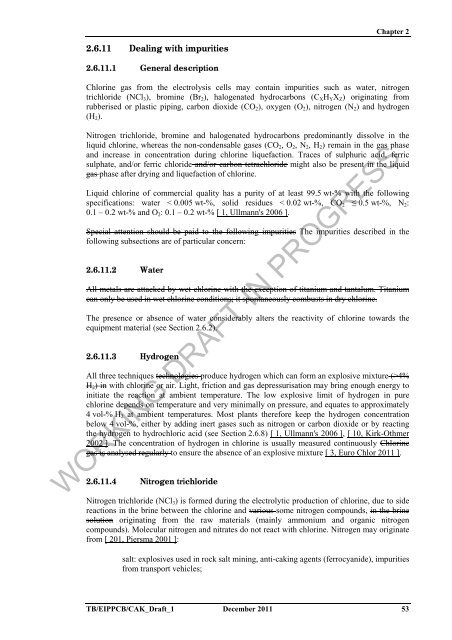(BAT) Reference Document for the Production of Chlor-alkali ...
(BAT) Reference Document for the Production of Chlor-alkali ...
(BAT) Reference Document for the Production of Chlor-alkali ...
Create successful ePaper yourself
Turn your PDF publications into a flip-book with our unique Google optimized e-Paper software.
2.6.11 Dealing with impurities<br />
2.6.11.1 General description<br />
Chapter 2<br />
<strong>Chlor</strong>ine gas from <strong>the</strong> electrolysis cells may contain impurities such as water, nitrogen<br />
trichloride (NCl3), bromine (Br2), halogenated hydrocarbons (CXHYXZ) originating from<br />
rubberised or plastic piping, carbon dioxide (CO2), oxygen (O2), nitrogen (N2) and hydrogen<br />
(H2).<br />
Nitrogen trichloride, bromine and halogenated hydrocarbons predominantly dissolve in <strong>the</strong><br />
liquid chlorine, whereas <strong>the</strong> non-condensable gases (CO2, O2, N2, H2) remain in <strong>the</strong> gas phase<br />
and increase in concentration during chlorine liquefaction. Traces <strong>of</strong> sulphuric acid, ferric<br />
sulphate, and/or ferric chloride and/or carbon tetrachloride might also be present in <strong>the</strong> liquid<br />
gas phase after drying and liquefaction <strong>of</strong> chlorine.<br />
Liquid chlorine <strong>of</strong> commercial quality has a purity <strong>of</strong> at least 99.5 wt-% with <strong>the</strong> following<br />
specifications: water < 0.005 wt-%, solid residues < 0.02 wt-%, CO2 Q 0.5 wt-%, N2:<br />
0.1 – 0.2 wt-% and O2: 0.1 – 0.2 wt-% [ 1, Ullmann's 2006 ].<br />
Special attention should be paid to <strong>the</strong> following impurities The impurities described in <strong>the</strong><br />
following subsections are <strong>of</strong> particular concern:<br />
2.6.11.2 Water<br />
All metals are attacked by wet chlorine with <strong>the</strong> exception <strong>of</strong> titanium and tantalum. Titanium<br />
can only be used in wet chlorine conditions; it spontaneously combusts in dry chlorine.<br />
The presence or absence <strong>of</strong> water considerably alters <strong>the</strong> reactivity <strong>of</strong> chlorine towards <strong>the</strong><br />
equipment material (see Section 2.6.2).<br />
2.6.11.3 Hydrogen<br />
All three techniques technologies produce hydrogen which can <strong>for</strong>m an explosive mixture (>4%<br />
H2) in with chlorine or air. Light, friction and gas depressurisation may bring enough energy to<br />
initiate <strong>the</strong> reaction at ambient temperature. The low explosive limit <strong>of</strong> hydrogen in pure<br />
chlorine depends on temperature and very minimally on pressure, and equates to approximately<br />
4 vol-% H2 at ambient temperatures. Most plants <strong>the</strong>re<strong>for</strong>e keep <strong>the</strong> hydrogen concentration<br />
below 4 vol-%, ei<strong>the</strong>r by adding inert gases such as nitrogen or carbon dioxide or by reacting<br />
<strong>the</strong> hydrogen to hydrochloric acid (see Section 2.6.8) [ 1, Ullmann's 2006 ], [ 10, Kirk-Othmer<br />
2002 ]. The concentration <strong>of</strong> hydrogen in chlorine is usually measured continuously <strong>Chlor</strong>ine<br />
gas is analysed regularly to ensure <strong>the</strong> absence <strong>of</strong> an explosive mixture [ 3, Euro <strong>Chlor</strong> 2011 ].<br />
2.6.11.4 Nitrogen trichloride<br />
WORKING DRAFT IN PROGRESS<br />
Nitrogen trichloride (NCl3) is <strong>for</strong>med during <strong>the</strong> electrolytic production <strong>of</strong> chlorine, due to side<br />
reactions in <strong>the</strong> brine between <strong>the</strong> chlorine and various some nitrogen compounds, in <strong>the</strong> brine<br />
solution originating from <strong>the</strong> raw materials (mainly ammonium and organic nitrogen<br />
compounds). Molecular nitrogen and nitrates do not react with chlorine. Nitrogen may originate<br />
from [ 201, Piersma 2001 ]:<br />
salt: explosives used in rock salt mining, anti-caking agents (ferrocyanide), impurities<br />
from transport vehicles;<br />
TB/EIPPCB/CAK_Draft_1 December 2011 53







